20 Easy Flowers To Grow So You Can Relax In The Garden
Here are the best low-maintenance flowers for your garden beds or containers.
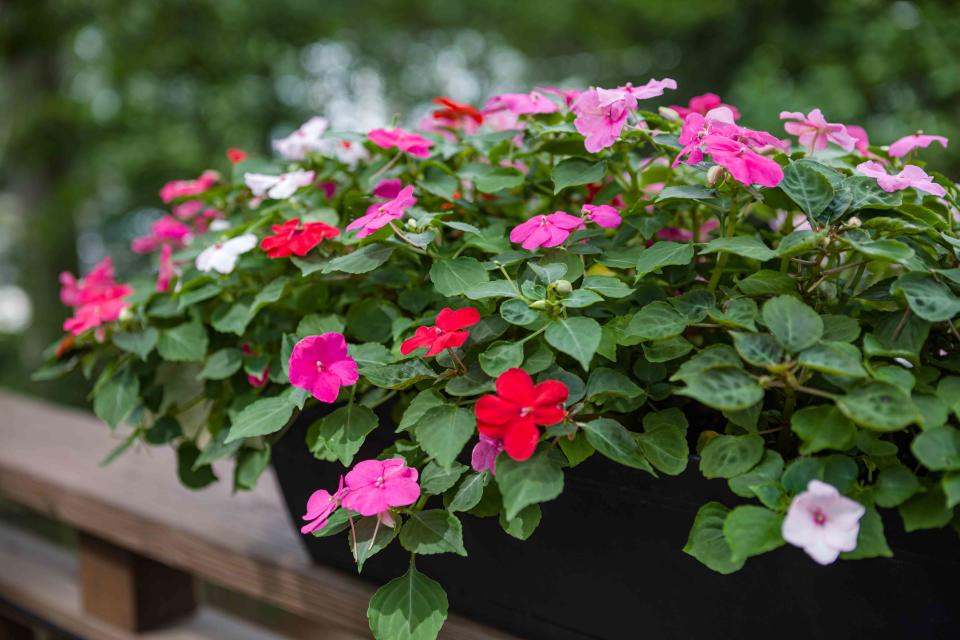
Getty Images
Fact checked by Khara Scheppmann
Whether you’re a new or experienced gardener, we understand that sometimes you’re just looking for easy flowers to grow. This is a no-judgment zone. You don’t have to obsess over your garden to enjoy colorful flowers all season long and attract pollinators such as butterflies and bees. If you crave color, long bloom times, and flowers you’re not going to have to coddle, there are many annuals and perennials that fit the bill.
One way to keep the color coming is to mix and match annuals, which live for one season, and perennials, which return for many seasons, throughout your beds and containers. Just be sure that any perennials you choose are suited to survive winters in your USDA Hardiness zone (find yours here).
The standard advice is that flowers planted in pots, window boxes and hanging baskets tend to dry out fast at the height of summer, so check them daily during hot, dry spells. Plus, you should use an all-purpose fertilizer regularly to keep the blooms coming. Not every gardener wants to face those tasks every day, so we've included a few drought-tolerant options that will do just fine without daily watering, not to mention bi-weekly fertilizing and frequent dead-heading. Ahead, here are our favorite easy-care blooms for any garden:
Marigolds
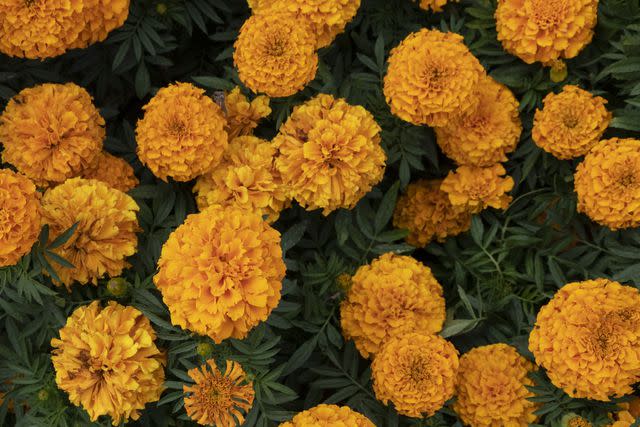
Getty Images
Botanical Name: Tagetes
Sun Exposure: Full
Soil Type: Well-drained
Soil pH: 6.0-7.0
Marigolds are at the top of the list for a reason: These sun-loving annuals are super-hardy, bloom from planting until a freeze, and have almost no pests. They come in heights ranging from 6 inches to 4 feet tall and their bright, cheery colors include pure gold, lemon yellow, and pumpkin orange. Marigolds are fairly drought-tolerant once established and will grow in almost any well-drained soil. You can pick up a six-pack of marigolds at the nursery or easily grow them from seed.
Sweet Alyssum
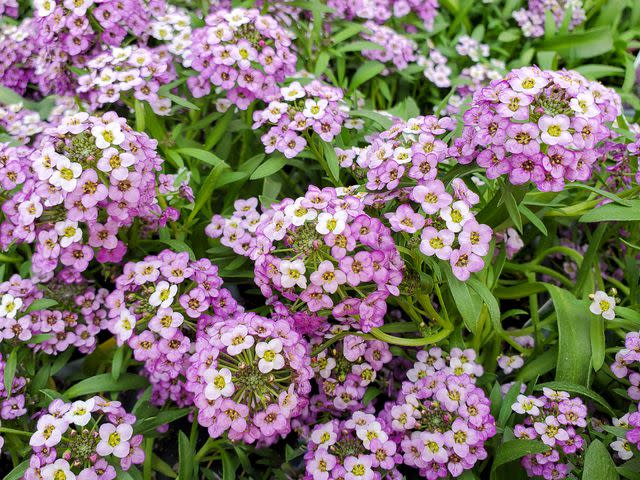
Getty Images
Botanical Name: Lobularia maritima
Sun Exposure: Full, partial
Soil Type: Well-drained but moist
Soil pH: 6.0-7.0
This low-growing annual looks amazing as an edging plant or when tumbling out of containers and window boxes. Sweet alyssum has clusters of usually white flowers with a honey fragrance, and pollinators adore it. It prefers the cooler weather of fall and winter in the Lower South, though it may bloom all summer in the Upper South. It likes full sun but appreciates afternoon shade in warmer climates. The plants require little pampering other than well-draining soil and watering during dry spells. Sweet alyssum often self-seeds, so you don't have to replant it the next spring.
Portulaca
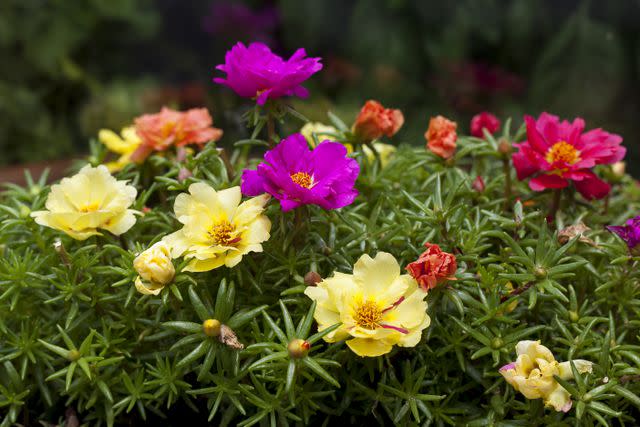
Getty Images
Botanical Name: Portulaca grandiflora
Sun Exposure: Full
Soil Type: Well-draining, sandy
Soil pH: 5.5-7.0
Portulaca, also known as moss rose, is a low-growing annual that thrives in poor or sandy soils in full sun. It has brilliant bloom colors from hot pink to pure orange. This succulent retains water in its fleshy leaves so it’s a good choice for hot, dry areas. It works equally well as a ground cover or in hanging baskets, and many types self-seed and will pop up in your garden again next year.
Daffodils
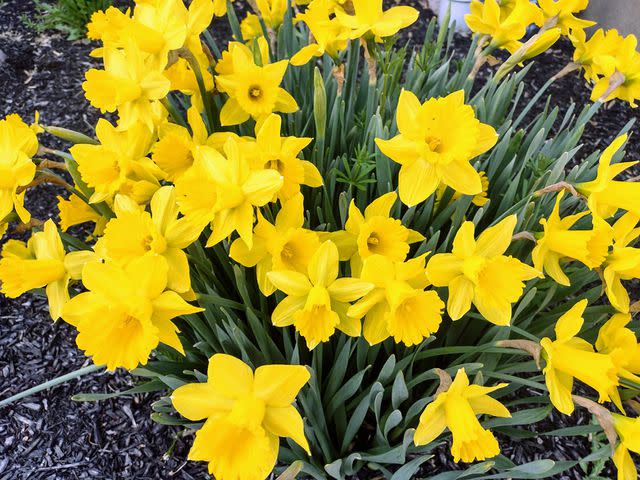
Getty Images
Botanical Name: Narcissus
Sun Exposure: Full, partial
Soil Type: Well-draining but moist, rich
Soil pH: 6.0-7.0
If you only plant one spring-flowering bulb in your yard, this is the obvious choice for the Upper, Middle, and Lower South. Daffodils come in an array of heights from 4 to 5 inches tall to 2 feet. Their bobbing golden heads are a sure sign that spring has arrived, and you won’t have to replant them next year. In addition, digging rodents that tend to chow down on other spring bulbs, such as tulips, tend to leave daffodils alone. The only hard part is waiting for the foliage to die before you trim them back.
Lantana
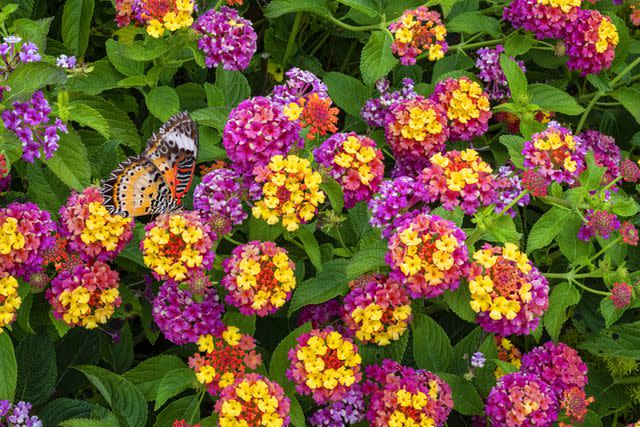
Getty Images
Botanical Name: Lantana camara
Sun Exposure: Full
Soil Type: Well-draining
Soil pH: 5.5-6.5
This shrubby, sun-loving plant has multi-colored flowers in shades of bright pink, peach, white, and yellow. Nowadays you can find compact varieties that only grow a foot tall. Lantana is treated as annual, though it can be perennial in the Lower, Coastal, and Tropical South. The plants are heat and drought-tolerant once established, though it does need occasional watering in containers. Butterflies and hummingbirds will flock to this plant.
Sedum
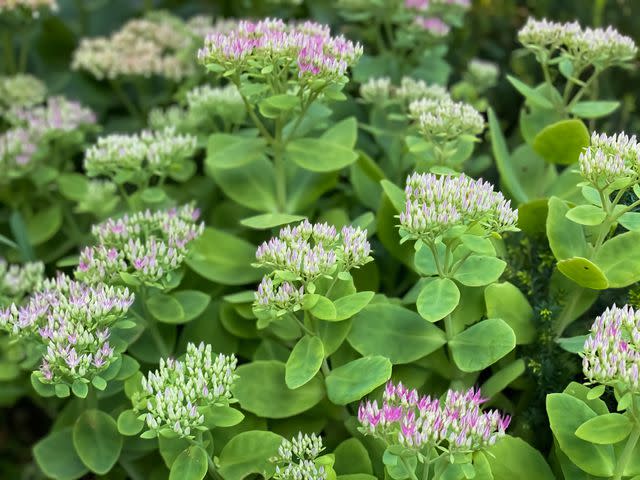
Getty Images
Botanical Name: Sedum spp., Hylotelephium spp.
Sun Exposure: Full
Soil Type: Well-draining
Soil pH: 6.0-7.0
Sedum is a great perennial for any garden because there are hundreds of varieties ranging from low-growing ground covers that bloom early to mid-summer to tall, upright types that bloom in late summer. Many sedums need full sun, and most have colorful foliage that is pretty even when not in bloom. These succulents are drought-hardy once established, and most will spread quickly if they’re happy with the conditions.
Catmint
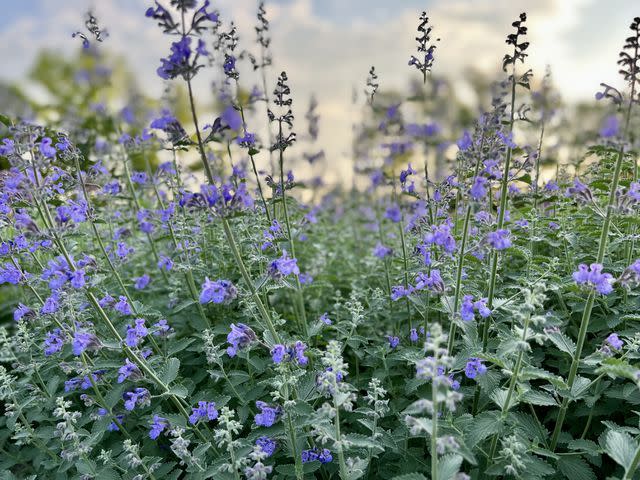
Getty Images
Botanical Name: Nepeta x faassenii
Sun Exposure: Full, partial
Soil Type: Well-draining
Soil pH: 6.0-8.0
Catmint is a drought-tolerant perennial with silvery-blue, spicy-scented foliage and purple spikes of flowers that bloom for months in full sun, though it can take some shade. Pollinators love it, but deer and rabbits typically don’t—a big draw for most gardeners. Look for newer varieties that stay more compact and upright and won’t overtake your garden, such as ‘Walker’s Low’ and ‘Cat’s Meow.’
Coral Bells
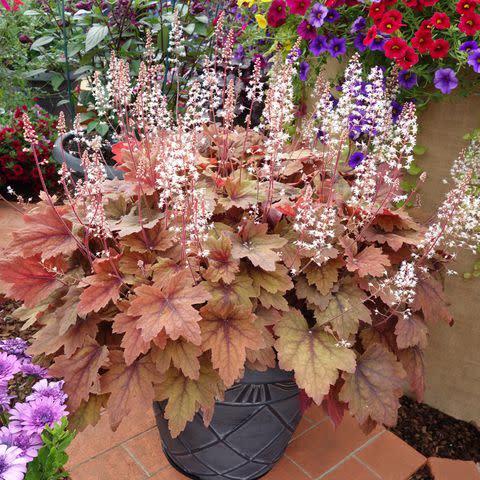
Getty Images
Botanical Name: Heuchera
Sun Exposure: Partial
Soil Type: Well-draining but moist
Soil pH: 6.0-7.0
Coral bells, also called heuchera, have exploded in popularity in recent years with many new cultivars available. These perennials are grown mostly for their vibrantly-colored foliage which comes in shades ranging from chartreuse to peach to nearly black. The dainty spikes of flowers, which hummingbirds love, appear over the mounded foliage in mid-summer, but their foliage alone makes them worth adding to your garden. Some tolerate sun, though most appreciate afternoon shade in hot climates.
Coleus
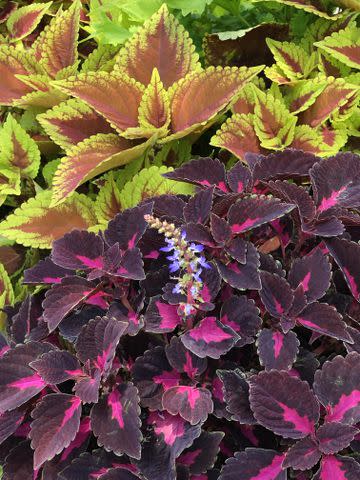
Getty Images
Botanical Name: Coleus scutellarioides
Sun Exposure: Full, partial, full shade
Soil Type: Well-draining, moist, rich
Soil pH: 6.0-8.0
Coleus is another plant that’s grown primarily for its bold foliage, which ranges from cherry red to lime green to brilliantly-colored variegated types. They make a striking container plant that lasts until frost. You may want to pinch back the small flowers as they appear to keep the foliage looking its best, though newer varieties don’t require as much maintenance. They’ll tolerate sun or shade, depending on the type, so read the label to know what you’re buying. Most do well in partial sun.
Calibrachoa
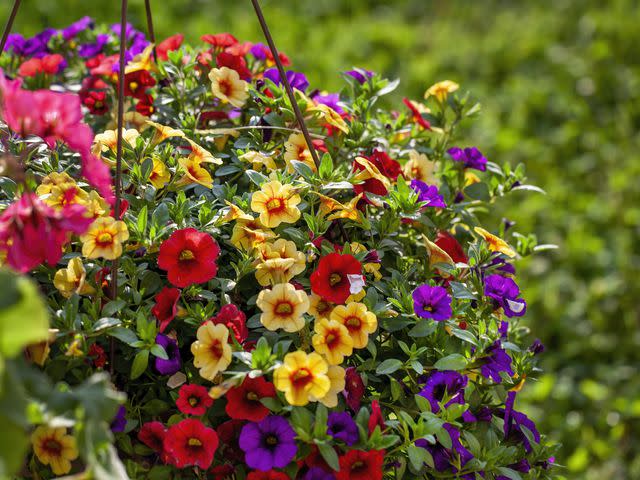
Getty Images
Botanical Name: Calibrachoa x hybrida
Sun Exposure: Full, partial
Soil Type: Well-draining, rich, loamy
Soil pH: 5.5-6.5
These full-sun annuals look like mini petunias, but they’re actually a different genus. Biggest selling point: You never have to deadhead, or remove spent blooms, to keep the flowers coming. They also stand up to heat and occasional dryness. Calibrachoa come in an astonishing array of stunning colors from pale lemon yellow to hot pink and orange. Mix and match them in hanging pots or window boxes, which display their draping forms to best advantage.
Mandevilla
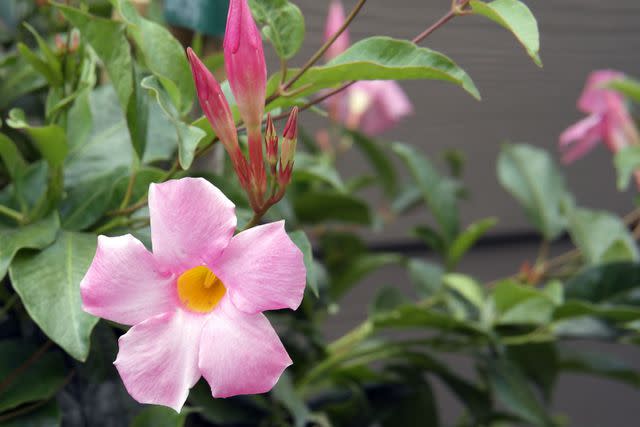
Getty Images
Botanical Name: Mandevilla sanderi
Sun Exposure: Full, partial
Soil Type: Well-draining but moist
Soil pH: 6.5-7.0
Add an exotic flair to your patio with pots of mandevilla. This sun-loving, fast-growing tropical vine is annual in the Upper and Mid-South but perennial in warmer zones. It’s available in pink, red, and white and is a favorite of hummingbirds and bees. Mandevilla appreciates afternoon shade in hot climates. Unless you live in southern Florida, enjoy it as a patio plant during summer, then bring it indoors for winter or just replace it like any annual.
Impatiens
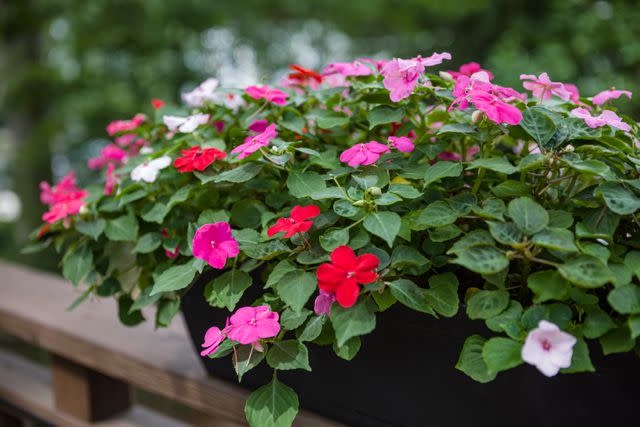
Getty Images
Botanical Name: Impatiens
Sun Exposure: Full, partial, dappled, depending on variety
Soil Type: Well-draining, moist, rich
Soil pH: 6.0-6.5
If you’re looking for a reliable shade bloomer available in many brilliant colors, plant impatiens, which keep the show going until a frost. New Guinea impatiens and its hybrids, such as the Bounce series, are a good choice if you’ve had past battles with downy mildew, a fungal disease that began to wipe out impatiens around 2013. Plus, they can handle more sun and aren't as quick to wilt. SunPatiens are the most sun-tolerant and wilt-resistant of all. All impatiens can handle summer heat and humidity but must be watered regularly.
Asters
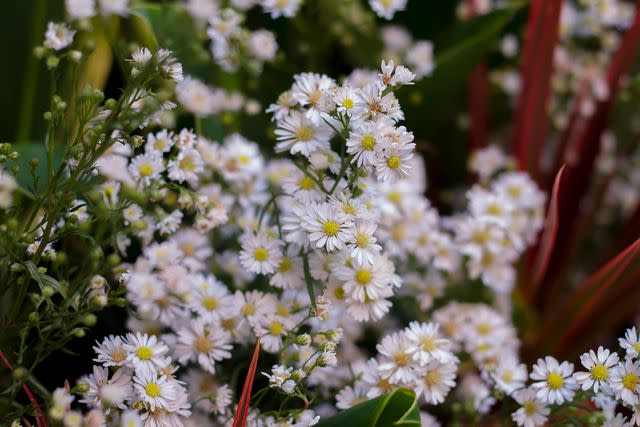
Aji Ilham Pratama/Getty Images
Botanical Name: Aster, Symphyotrichum, and Eurybia spp.
Sun Exposure: Full, partial
Soil Type: Rich, loamy, clay
Soil pH: 5.0-8.0, varies by species
Asters are late summer or fall bloomers with small, daisy-like flowers. They can be white, purple, pink, or blue. Some prefer full sun and others partial, but all are butterfly and bee magnets at a time of year when other plants may be starting to shut down. If that's not enough reason to plant one, many varieties also become drought-tolerant and gradually spread in the garden. Most asters can grow in Zones 4 to 8.
Zinnias
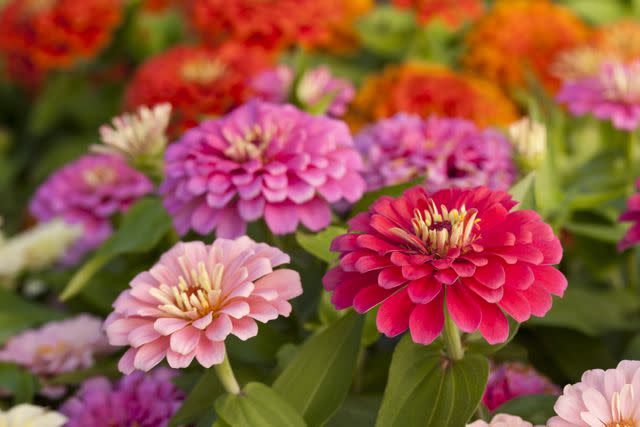
Getty Images
Botanical Name: Zinnia elegans
Sun Exposure: Full
Soil Type: Well-draining
Soil pH: 5.5-7.5
Cheerful zinnias are hard to resist, especially once you know how hardy they are in the garden. Zinnias like average, well-draining garden soil and become drought-tolerant once established. They need sun and warm weather to survive and will bloom until first frost (deadhead the flowers to encourage more blooms). Deer and rabbits generally leave them alone, but pollinators are attracted by the flowers. Zinnias do well in a meadow, cutting garden, or summer containers, so there's always a place for these colorful flowers. This is another plant that's easy to grow from seed.
Daylilies
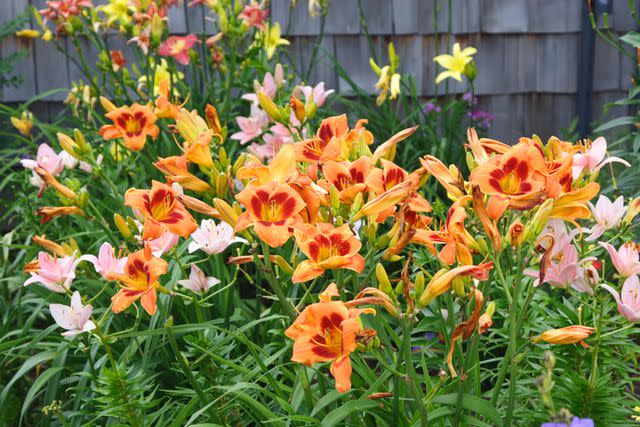
Getty Images
Botanical Name: Hemerocallis
Sun Exposure: Full
Soil Type: Well-drained, rich
Soil pH: 6.5-7.0
This summer bloomer opens each flower for one day only. A big patch (and daylilies do spread) can create a profusion of flowers. Daylilies may like rich, loamy, moist soil, but we've seen them tough it out in clay that's been amended with some organic matter. These plants bloom best with at least six hours of sun, but appreciate some afternoon shade during the South's hotter hours. Unfortunately, deer do enjoy munching on daylilies.
Columbine
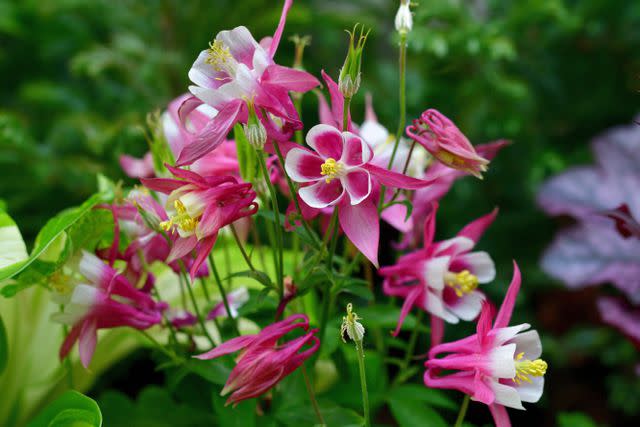
Getty Images
Botanical Name: Aquilegia
Sun Exposure: Full, partial, dappled
Soil Type: Well-drained, loamy
Soil pH: Acidic to neutral
Columbine is a vigorous springtime bloomer for shadier areas of the garden. The flowers can also grow in full sun with adequate moisture. In the Southeast, wild columbine (A. canadensis) grows in open forest and has small, spurred red flowers. It will freely seed around your garden. Many of the types found at garden centers boast big blooms in pinks, whites, and purples.
Dianthus
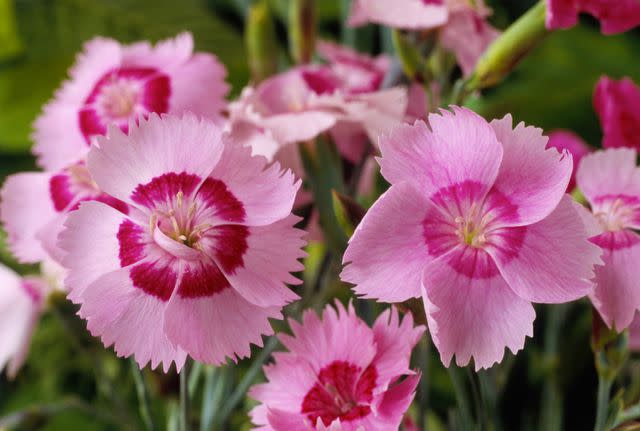
Chris Burrows/Getty Images
Botanical Name: Dianthus spp.
Sun Exposure: Full
Soil Type: Well-drained, rich
Soil pH: 6.5-7.5
Dianthus is in the same genus as carnations and sweet Williams. Plant it in rich, well-draining soil, and dianthus won't require a lot of fuss once it's established. Deadheading does encourage more flowering. The blooms come in pink, red, and white, and may grow a foot or taller or hug the ground. Dianthus looks beautiful tucked into containers or at the base of taller perennials.
Pansies
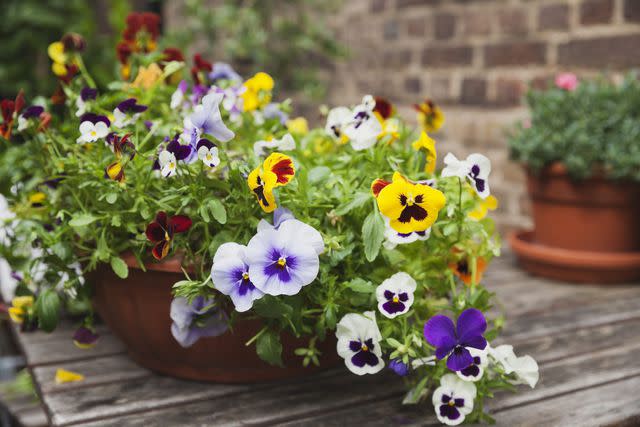
Botanical Name: Viola x wittrockiana
Sun Exposure: Full, partial
Soil Type: Rich, well-drained but moist, loamy
Soil pH: 5.4-6.0
Pansies keep the Southern garden going in winter and early spring when so little else is blooming. They thrive in containers filled with rich, loamy, moist soil in full or partial sun. Plant them in fall and enjoy them for months, watering during dry spells (in winter, this may rarely occur). Replace pansies with summer annuals once the temperature rises.
Cranesbill Geraniums
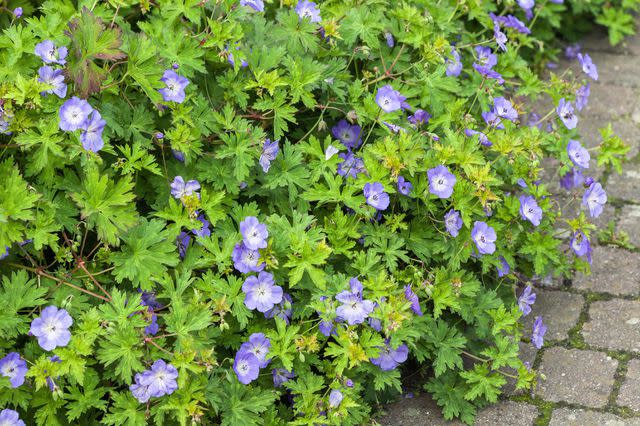
Getty Images
Botanical Name: Geranium spp.
Sun Exposure: Full, partial
Soil Type: Well-drained, average garden soil
Soil pH: 6.0-7.5
This under-used perennial has become more popular for good reason. Hardy geraniums can be grown in Zones 4 to 8 in average soil with little supplemental watering required except during drought. Colors range from purple to pink and the low-growing foliage makes an attractive ground cover. You can shear the plants to shape and neaten them, or just let them sprawl.
Black-Eyed Susans
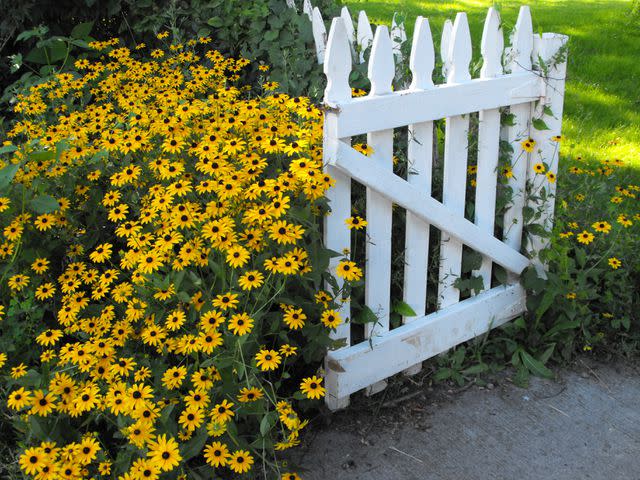
Getty Images / Jennifer Shields
Botanical Name: Rudbeckia hirta, R. fulgida
Sun Exposure: Full, partial
Soil Type: Well-drained, average soil
Soil pH: 5.5-6.5
This easy biennial or short-lived perennial is a beacon for butterflies in the summer garden. Black-eyed Susan blooms at the end of hot, humid summers when other plants are wilting. Finches and other seed-feeding songbirds are drawn to the seed heads in fall. Black-eyed Susan also self-seeds in the garden to keep your fence line looking fabulous. Avoid planting it in overly rich soil.
For more Southern Living news, make sure to sign up for our newsletter!
Read the original article on Southern Living.

